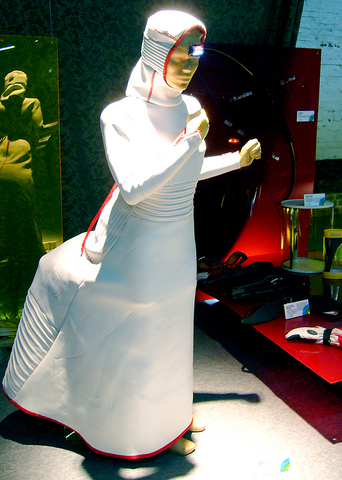For readers in the Kaohsiung area looking to fill their apartments with stuff they really don't need but feel they should have anyway, a visit to 2005 Taiwan Design Expo (台灣設計傳覽會) is in order.
The expo runs until Oct. 30 at the city's Wei Wu Military Camp
Co-sponsored by the Kaohsiung County Government this year's event focuses on everyday household products under the theme "Discover the New Home in Asia." Divided into five categories, the expo introduces a smorgasbord of new designs ranging from furniture to kitchen utensils and children's playthings.

PHOTO: GAVIN PHIPPS, TAIPEI TIMES
Those looking to spend their hard-earned cash on stuff that looks nice but that one can live without or, as the official English language guide puts it: "[to] learn creative esthetics of living up your life and building a [perfect] home."
From innovative and, admittedly, quite comfortable bamboo and wickerwork furniture, to two-person bathtubs, the expo features just about every conceivable form of product design. Some of the objects are already on the market, some of them are manufactured to order and others are, well, simply so batty that it makes you wonder why anybody would get paid to design them let alone why anybody would possibly want to buy them.
Visitors can wonder through the long disused military base's barracks and take in the contents of over a dozen specially designed pavilions.
"The Future Pavilion" predictably enough features futuristic designs for furniture and household objects, many of which look like they've come straight off the 1960s sci-fi TV series Space 1999.
The most interesting of the pavilions is the one dedicated to international design. The wide array of oddball household objects on display here includes ergonomic oven gloves that resemble flippers, a tubular cognac bottle that looks like it belongs on the International Space Station, gaudy 1970s-styled plastic tea pots and tea sets that wouldn't look out of place on an episode of the Brady Bunch.
The most inane of the lot, however, is the French-designed wedding dress that doubles as all-purpose sportswear and allows any modern bride the freedom to go for a quick jog before saying "I do."
The wildest pavilions are the "The Green" and "Home Forest" pavilions, which are filled with over-the-top bamboo structures designed to transform living spaces into urban
jungle-like environments.
Along with showcasing the oddball human aspects of modern design the expo also features a special area dedicated to pets. Here visitors can see outrageous designs for "pet houses" for dogs, cats and even hamsters. It's pretty inane, but it does make for an interesting and certainly mind opening visit.
Performance notes:
What: Taiwan Design Expo 2005
Where: Wei Wu Military Camp, Nanking Rd, Fangshan City, Kaohsiung County
When: Until Oct. 30.

Most heroes are remembered for the battles they fought. Taiwan’s Black Bat Squadron is remembered for flying into Chinese airspace 838 times between 1953 and 1967, and for the 148 men whose sacrifice bought the intelligence that kept Taiwan secure. Two-thirds of the squadron died carrying out missions most people wouldn’t learn about for another 40 years. The squadron lost 15 aircraft and 148 crew members over those 14 years, making it the deadliest unit in Taiwan’s military history by casualty rate. They flew at night, often at low altitudes, straight into some of the most heavily defended airspace in Asia.

Beijing’s ironic, abusive tantrums aimed at Japan since Japanese Prime Minister Sanae Takaichi publicly stated that a Taiwan contingency would be an existential crisis for Japan, have revealed for all the world to see that the People’s Republic of China (PRC) lusts after Okinawa. We all owe Takaichi a debt of thanks for getting the PRC to make that public. The PRC and its netizens, taking their cue from the Chinese Communist Party (CCP), are presenting Okinawa by mirroring the claims about Taiwan. Official PRC propaganda organs began to wax lyrical about Okinawa’s “unsettled status” beginning last month. A Global

Taiwan’s democracy is at risk. Be very alarmed. This is not a drill. The current constitutional crisis progressed slowly, then suddenly. Political tensions, partisan hostility and emotions are all running high right when cool heads and calm negotiation are most needed. Oxford defines brinkmanship as: “The art or practice of pursuing a dangerous policy to the limits of safety before stopping, especially in politics.” It says the term comes from a quote from a 1956 Cold War interview with then-American Secretary of State John Foster Dulles, when he said: ‘The ability to get to the verge without getting into the war is

Like much in the world today, theater has experienced major disruptions over the six years since COVID-19. The pandemic, the war in Ukraine and social media have created a new normal of geopolitical and information uncertainty, and the performing arts are not immune to these effects. “Ten years ago people wanted to come to the theater to engage with important issues, but now the Internet allows them to engage with those issues powerfully and immediately,” said Faith Tan, programming director of the Esplanade in Singapore, speaking last week in Japan. “One reaction to unpredictability has been a renewed emphasis on